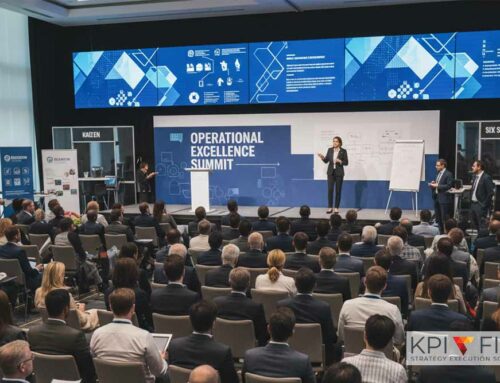Are your teams mistaking activity for progress? Every organization has big plans, but only a few successfully execute them, and the secret to bridging that gap lies in focusing on Critical Success Factors (CSFs). In this article, we’ll explain not only what CSFs are but also how to identify them, align them with your core business goals, and most importantly, track them effectively. With the right approach—and tools like KPI Fire to link your CSFs directly to real-time KPIs and initiatives—you can stop managing everything and start managing what truly matters.
What Are Critical Success Factors?
A Critical Success Factor (CSF) is the bedrock of your strategic plan. Forget the endless list of tasks and minor goals; CSFs define the handful of crucial elements—typically four to eight—that must be executed flawlessly for your strategy to materialize. They answer the fundamental question: What must we be excellent at to win in our market and achieve our highest objectives?
In essence, a CSF is a high-level area of focus—a non-negotiable prerequisite for victory. These aren’t metrics; they are the strategic capabilities or conditions that demand constant management attention and resource investment.
For example:
- In tech, a CSF might be “Drive Continuous Product Innovation.“
- In retail, it might be “Deliver a Seamless Omni-Channel Customer Experience.”
- In manufacturing, it could be “Maintain World-Class Operational Safety and Efficiency.”
Critical Success Factors vs. KPIs: A Necessary Distinction
This is where many organizations get tripped up. While CSFs and KPIs work hand-in-hand, they are fundamentally different tools with different jobs. Mixing them up leads to a lack of focus and poor accountability.
The simplest way to understand the difference is to see the relationship as Action vs. Measurement:
- CSFs are the Cause (The Activity): They are the actions, competencies, or conditions you must master. They describe the qualitative, strategic area where excellence is required.
- KPIs are the Effect (The Metric): They are the quantifiable, often numerical, metrics that tell you how well you are performing in that CSF area. They measure the output of your actions.
Think of it this way: If your strategic goal is to sail a ship to a new port, your CSF is the “Having a Skilled Crew and Seaworthy Vessel.” Your KPI is the “Average knots per hour“ or the “Fuel consumption rate.” The CSF makes the success possible; the KPI proves it’s happening.
How CSFs Drive Focus and Alignment
Once you’ve meticulously defined your Critical Success Factors, they transition from a planning concept to the dynamic operating blueprint for your business. CSFs are arguably your most potent tool for translating a lofty vision into daily, accountable execution.
Here is how CSFs drive unmatched focus and organizational alignment:
1. The Strategic Funnel: Zeroing in on What Matters
In the modern business environment, it’s easy to mistake a lot of effort for actual progress. CSFs act as a rigorous filter, ensuring you invest time and money only where it delivers the highest return on strategy.
CSFs Reject “Good Ideas” That Don’t Fit: By defining the few areas that are truly non-negotiable for success, you gain the clarity—and courage—to say “no” to projects and initiatives that are merely “nice-to-have.”
Optimal Resource Allocation: When a CSF is established (e.g., “Reduce Customer Churn Rate”), it instantly validates projects like service retraining and feedback loop redesign, while pushing back on unrelated initiatives that would otherwise dilute your resources. This ensures your capital and talent are always deployed against the most important strategic targets.
2. Silo-Busting: Creating Unified Organizational Goals
Functional silos occur when departments optimize their local performance at the expense of the company’s overall success. A CSF forces these teams to align their efforts toward a common strategic star.
Imagine a CSF: “Be the Market Leader in Product Speed and Reliability.” This mandate immediately demands cross-functional collaboration, in other words synchronization across the organization:
- Product Development must prioritize stability and rapid deployment.
- Operations must enforce stricter quality control and maintenance protocols.
- Marketing must communicate speed and reliability, not just features.
By providing a single, shared definition of success, CSFs ensure every major department is pulling the rope in the same direction, turning internal friction into forward momentum.
3. The Execution Chain: Connecting Strategy to the Front Line
CSFs close the notorious gap between the executive boardroom and the day-to-day tasks of frontline employees. They serve as the critical middle tier in your organizational hierarchy of performance.
This robust structure ensures that every time someone hits a KPI, completes an initiative, or reports progress, they know exactly which Critical Success Factor they are supporting and how it contributes to mastering business strategy.
Defining Your CSFs: A 4-Step Process for Clarity
Identifying your Critical Success Factors is not a brainstorming session; it’s a rigorous, focused process that converts your broad strategy into a short, manageable list of priorities. Follow these four steps to cut through the clutter and define the CSFs that truly matter for your organization:
Step 1: Start with Your Strategic Goals and Outcomes
Before you can define how you will succeed, you must define what success looks like. Your CSFs must be chained directly to your highest-level business objectives and outcomes (e.g., doubling market share, launching a new product line, achieving operational excellence).
- Action: Review your company’s mission, vision, and the top 3-5 strategic goals for the next one to three years.
- Key Question: For each goal, ask: “What are the absolute, make-or-break elements that must be in place, or executed flawlessly, for us to achieve this outcome?”
Step 2: Analyze the External and Internal Environments
CSFs don’t exist in a vacuum. They are often dictated by forces outside your walls or weaknesses within your organization. Use proven analytical frameworks to uncover these critical areas.
- External View (Industry & Competition): Look at your industry landscape. What gives your competitors an edge? What industry-wide standards (e.g., regulatory compliance, supply chain speed) must you meet just to stay in the game? This often generates Industry-Related CSFs.
- Internal View (Strategy & Weaknesses): Conduct a quick SWOT analysis or review past project failures. Do you repeatedly fail to hit deadlines because of poor communication? This may highlight a Management-Position CSF like “Promote Cross-Functional Accountability.”
Step 3: Filter and Select the Essential Few
The biggest mistake is having too many CSFs, which leads to a loss of focus. The power of the CSF methodology lies in its scarcity. You should aim for no more than five to eight CSFs across the entire organization or for a major strategic goal.
- Action: Gather all the potential factors identified in Steps 1 and 2. Consolidate overlapping ideas.
- The Litmus Test: For each potential CSF, ask: “If we failed at this, would our strategic goal be impossible to achieve?” If the answer is “no,” it’s a great task or project, but it is not a Critical Success Factor.
Step 4: Validate and Socialize the CSFs
A CSF is useless if it’s only understood by the executive team. Once you have finalized your short list, they must be clear, concise, and communicated throughout the organization so they can begin to drive behavior.
- Validation: Share the list with key stakeholders and departmental leaders. Do they agree these are the true drivers of success? Are they unambiguous?
- Integration: Ensure every department understands how their team’s priorities contribute to one or more of the CSFs. This is the stage where you begin linking the CSFs to the strategic initiatives and KPIs used to track progress (a perfect job for a platform like KPI Fire).
Critical Success Factors Examples
Here are examples of CSFs for the Manufacturing and Project Management industries:
Manufacturing Examples
CSFs in manufacturing focus on operational excellence, quality, cost control, and supply chain efficiency.
| Critical Success Factor (CSF) | Description |
|---|---|
| Operational Efficiency & Throughput | The ability to maximize production output (throughput) while minimizing waste, downtime, and cycle time. |
| Product Quality & Reliability | Ensuring that products meet or exceed design specifications and customer expectations consistently (e.g., maintaining a low defect rate/high yield). |
| Cost Management & Waste Reduction | Effectively controlling the total manufacturing cost per unit (labor, materials, overhead) and relentlessly pursuing the elimination of all forms of waste (lean manufacturing). |
| Supply Chain Stability | Ensuring a reliable, high-quality, and on-time supply of raw materials and components to meet the production schedule without excessive inventory. |
| Workforce Safety & Skill Development | Maintaining a safe working environment (zero major incidents) and having a skilled, cross-trained workforce capable of operating and maintaining modern equipment. |
| Equipment Reliability (Uptime) | Ensuring that key machinery and assets are highly available and experience minimal unplanned downtime (e.g., effective preventive maintenance). |
Project Management Examples
CSFs in project management are often universal, focusing on the core constraints (scope, time, cost) and stakeholder alignment.
Integrating CSFs and KPIs for a Complete Performance Picture
Defining your Critical Success Factors is the crucial first step; the final, and most vital, step for any high-performing organization is the flawless integration of these CSFs with your execution metrics, or Key Performance Indicators. This is the convergence point where high-level strategy meets day-to-day operations.
The goal is to establish an unbroken “line of sight” from every daily activity up to the corporate mission.
Mapping for Accountability
To achieve this complete performance picture, you must map your KPIs to your CSFs in a clear, unambiguous way. Below is a generic example demonstrating how such a table might be structured and filled to show the Mapping for Accountability between CSFs and KPIs.
This is an example for an IT Service Desk:
| Critical Success Factor (CSF) | Key Performance Indicator (KPI) | Accountability / Target |
|---|---|---|
| Improve Customer Satisfaction | Customer Satisfaction (CSAT) Score | Maintain positive rating |
| Enhance Operational Efficiency | Mean Time to Resolve (MTTR) | Reduce average MTTR to hours |
| Maintain System Reliability | System Uptime Percentage | Maintain monthly uptime |
Explanation of the Structure:
- Column 1 (CSF): Defines the major areas that must go well for the organization to succeed.
- Column 2 (KPI): Defines the measurable metrics that track performance toward the CSF.
- Column 3 (Accountability / Target): Sets the specific, unambiguous goal for the KPI, often linking it to the responsible team or manager.
You would replace the values above with your own organization’s specific CSFs and their corresponding KPIs.




